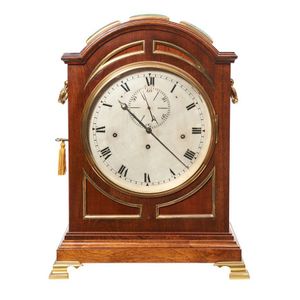George III Table Regulator Clock, Circa 1810
You must be a subscriber, and be logged in to view price and dealer details.
Subscribe Now to view actual auction price for this item
When you subscribe, you have the option of setting the currency in which to display prices to $Au, $US, $NZ or Stg.
- Circa - A Latin term meaning 'about', often used in the antique trade to give an approximate date for the piece, usually considered to be five years on either side of the circa year. Thus, circa 1900 means the piece was made about 1900, probably between 1895 and 1905. The expression is sometimes abbreviated to c.1900.
- Movement - The technical name for the workings of a clock or watch, and does not include the dial or case.
- Bezel - On a clock or watch, the bezel is the metal frame into which the watch or clock glass is fitted. In clocks, the bezel may include a hinge and a flange, in effect a door to the face of the clock. In jewellery the bezel is a band of metal with a projecting lip that holds the gemstone in its setting.
- Pendulum - The pendulum was discovered around 1602 by Galileo Galilei, and was adopted for time keeping by the Dutch mathematician and natural philosopher, Christiaan Huygens, who excelled in astronomy, physics, and horology.
The pendulum comprises a metal rod usually of brass or steel with a metal disk, known as a bob, at the end. The movement of the pendulum is driven by weights or a spring, and as a pendulum swings in a regular arc, it was found accuracy could be controlled to within a few seconds a week.
Timekeeping can be adjusted by changing the height of the bob on the rod, making the pendulum either swing slower or faster.
The disadvantage of the pendulum was that changes in temperature also changed the length of the pendulum, interfering with the accuracy of the clock, and so in the 18th century two types of mercurial pendulums were invented which countered the movement in the steel rod.
The pendulum was the world's most accurate timekeeping technology until the invention of the quartz clock, regulated by a quartz crystal, in 1927. - George Iii - George III (1738 - 1820) was King of Great Britain and Ireland from 1760 to 1820.
- Fusee - The fusee movement was used in clocks and pocket watches from the mid 17th century. The fusee is a cone shaped drum within the works that is linked to the barrel of the spring, usually by a length of chain.
As the mainspring loses its tension over time, the cone shaped barrel compensates for this by increasing the tension, by pulling the mainspring tighter, thus ensuring the time remains constant.
Use of the fusee in clocks was superseded by the "going barrel" in the mid 19th century and for pocket watches at the beginning of the 19th century.
The fusee continued to be used in marine chronometers until the 1970s. - Maintaining Power - A horological term to describe a subsidiary driving force such as a spring or additional weight in a clock, which keeps the movement going while the mainspring is being rewound.
This item has been included into following indexes:
Visually similar items

Maples London Edwardian walnut bracket clock having brass bindings, a brushed metal face with Roman numerals, with keys. Condition: good, overall good order, needs a service, height 33 cm

Regency mahogany bracket clock white dial with Roman numerals, lion ring handles and glazed side panels and back door, moulded brass fee, two fusee movement unsigned and untested, height 50 cm

A Regency mahogany bracket clock by James Edwards of London, the rectangular case with decorative brass inlay including stringing, the stepped top with gilt finial, the cream painted dial with black painted numerals, gilt captured ring side handles and dec

A Victorian mahogany bracket clock with enamel dial
